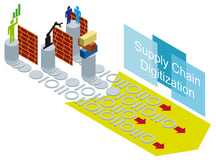Why the Future of Supply Chain Management is Digital
Jesse Kelber - September 10, 2019

 Are you ready for a digital supply chain? Industry 4.0 is revolutionizing the manufacturing end, while its offshoot Logistics 4.0 is doing the same for the shipping end of the chain. But what about all the connecting pieces in the middle? Is your company ready to adopt the technologies and techniques that will fully digitize your end-to-end supply chain, or are you still using pen and paper to track your warehouse inventory? With the continued adoption of these technologies, the future of the supply chain is going digital, and there are a number of reasons digital will rule. Already, we’re seeing major inroads on the part of IoT sensors, RFID tags, smart pallets and GPS tracking leading the charge. Is your company ready to adopt and adapt? Or will you find yourself left behind as your competitors step into the digital gap?
Are you ready for a digital supply chain? Industry 4.0 is revolutionizing the manufacturing end, while its offshoot Logistics 4.0 is doing the same for the shipping end of the chain. But what about all the connecting pieces in the middle? Is your company ready to adopt the technologies and techniques that will fully digitize your end-to-end supply chain, or are you still using pen and paper to track your warehouse inventory? With the continued adoption of these technologies, the future of the supply chain is going digital, and there are a number of reasons digital will rule. Already, we’re seeing major inroads on the part of IoT sensors, RFID tags, smart pallets and GPS tracking leading the charge. Is your company ready to adopt and adapt? Or will you find yourself left behind as your competitors step into the digital gap?
Information Silos are Holding You Back
One of the biggest stumbling blocks encountered by supply chain professionals is simply access to information. In order to plan effectively, you need to know what’s going on upstream, as well as downstream, from you. The historical model of paper inventories and shipping manifests that never leave the loading dock won’t cut it anymore when your factory is being monitored by IoT sensors and your orders in transit are being tracked by RFID and GPS. If you can find out down to the minute when your raw materials order will arrive but have no idea if you have room in the warehouse for it to be stored until needed, you’ll understand the need for full transparency. Digitization is the key to unlocking this level of visibility.
You’ll know when that order will arrive, precisely when and where it will be used, and the best route for your warehouse crew to efficiently transport it to and from the available shelf space. No more silos slowing you down and giving your already digital competitors the edge because they can track everything from weather conditions at the departure port to fuel prices for the trucks waiting to receive and transport that shipment to the customer. When your entire team has access to the same information via the same dashboard interface, your planner in Asia can get the information they need to schedule that raw materials order and your scheduler at the factory in Mexico can adjust production accordingly. That means more on-time deliveries and consistently happy customers.
As alluded to, you may already be working with planners and schedulers around the world. Suppliers in Asia, factories in Central America, and buyers in Europe mean that speed, accuracy, and flexibility will be the currency that keeps you competitive as we enter the middle of the 21st Century. Real-time information availability up and down the chain is crucial to succeeding in this global marketplace. Your suppliers need to know when to ship your materials, your production planners need to know exactly when that order will arrive and your shipping coordinators need to know when to tell the customer their order will be delivered. Digitization breaks down the information silos of old and makes way for the stream of data that a digital supply chain runs on. And when all of that data is available on-demand regardless of time zone, the true power of the digital supply chain can be realized.
Adoption Rates for Industry 4.0 Technologies Will Continue to Rise
When your production facility is fully digitized and sending your data faster than you can print it out and get it on a clipboard for the warehouse manager, once again you’ll see the need for full digital transformation. Manufacturing plants are becoming more and more efficient with the arrival and adoption of Industry 4.0 tech like IoT sensors and RFID tracking. The lessening of necessary downtime and shortening of lead times these technologies make possible means the rest of your supply chain needs to quicken its pace if it hopes to keep up. When an order is ready to go, but there are no trucks at the loading dock to pick up the product, delays will slow down the works, ultimately leading to late delivery and unhappy customers. In today’s market of on-demand ordering and next day (or next hour) delivery expectations, delays are becoming inexcusable.
The Ascendance of Postmodern ERP
Postmodern ERP refers to the interconnection and interaction between business systems. Gone are the days when someone had to manually download data from the inventory system then manually upload it into the ERP so finance could run their spreadsheets and send out invoices. The interoperability of all backend business systems with warehouse systems and production systems means that complete visibility has been achieved. What you don’t want is your competitors to adopt this level of advanced technology if you’re still stuck in the pen and paper mode. If that happens, your customers who are digital will shop around and find someone whose systems play well with their own and you’ll be left in the dust. Bottom line, if you don’t adopt and adapt the technology necessary to integrate with your suppliers and customers, you will be left behind.
Advanced Analytics Decrease Bottom Lines and Increase ROI
Predictive analytics stand to change the face of logistics planning and demand forecasting. The use of AI and machine learning is leading to software that can adapt and adjust everything from production run timing to shipment routing, all in real-time. Add to that the mountain of data being generated by already in place systems, and pretty soon those same analytic capabilities will be able to conduct the majority of planning activities down to a fine-grained level (think the ability to time trucks to arrive just as the last one pulls away from the dock, cutting load-out times dramatically).
Meanwhile, demand forecasting has always been at the mercy of seemingly unpredictable forces like weather incidents, fuel prices, and market fluctuations. Advanced analytics will be able to take advantage of instantaneous updates from sensors around the world combined with your internal databases and render such issues a thing of the past. With these AI-powered predictive analytics soon to be available, we could be seeing reductions in forecasting errors in the 30-50% range in the very near future.
LATEST POSTS
- Understand Why Production Planning Needs Specialized Solutions
- Understand Circular Economy in The Manufacturing Industry
- How Can Industry 4.0 IT Integration Be Achieved Smoothly?
- The Significance of Order Sequencing in Discrete Manufacturing
- How to improve your Supply Chain Management: The Power of Control Towers



